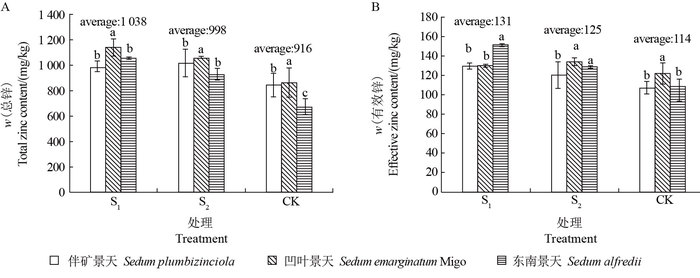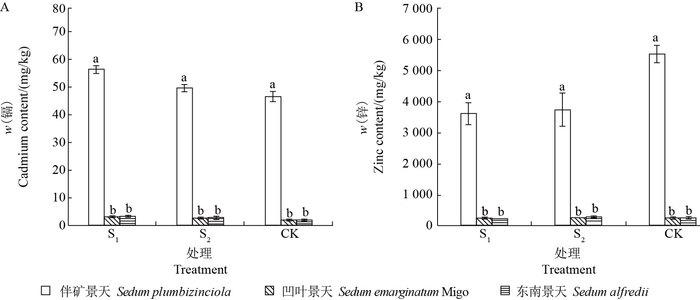| 耐镉菌联合植物吸收对土壤重金属镉污染的修复 |
2. 杭州市植保土肥总站,杭州 310020
2. Plant Protection Station of Hangzhou City, Hangzhou 310020, China
随着矿产资源的大量开发利用,工业生产的迅猛发展和各种化学产品、农药及化肥的广泛使用,含重金属的污染物通过各种途径进入环境,造成土壤,尤其是农田土壤重金属污染日益严重。重金属污染物不能被化学或生物降解,易通过食物链途径在植物、动物和人体内积累,毒性大,对生态环境、食品安全和人体健康构成严重威胁。因此,农田土壤重金属污染已成为当前日益严重的环境问题[1],而土壤系统中重金属的污染和防治一直是国内外研究的热点和难点[2]。重金属污染土壤的修复主要基于2种策略:一是去除化,将重金属从土壤中去除,达到清洁土壤的目的;二是固定化,将重金属固定在土壤中限制其释放,从而降低其风险。近年来,关于重金属污染土壤的修复技术研究取得了长足发展,按照工艺原理主要分为物理/化学修复、生物修复和农业生态修复[3-4]。
微生物特别是细菌,数量众多,比表面积大,带电,代谢活动旺盛。耐镉微生物在修复被重金属污染的土壤方面具有独特的作用,其不仅可以通过吸附和累积重金属来降低土壤中重金属的毒性,并以此来净化有毒重金属污染或回收有经济价值的重金属[5],而且可以通过其代谢活动及代谢产物促进重金属的溶解,使土壤中呈固态的重金属活化成为可溶态或交换态,便于植物吸收富集,从而大幅度提高植物修复效率,解决植物修复技术中土壤重金属低生物有效性的限制[6-7]。许多研究者对土壤中的耐镉菌进行了研究,我们也从杭州市富阳区电镀厂污染土壤中分离到了一株具有强活化作用的耐镉菌株m6,并对其系统发育地位进行了鉴定:该菌在系统发育地位上属于细菌界(Bacteria);放线菌纲(Actinobacteria);放线菌亚纲(Actinobacteridae);放线菌目(Actinomycetales);微球菌科(Micrococcineae);节细菌属(Arthrobacter)[8-9]。普通表面活性剂能活化土壤中的重金属,提高重金属在土壤中的迁移性和生物可利用性,对去除污染土壤和沉积物中的重金属有积极的效果。胡随喜等[10]研究发现,十二烷基苯磺酸钠的质量浓度为35~45 mg/L时,它对土壤中重金属镉具有最佳去除效果。因此,本文采用野外盆栽试验和大田试验,与表面活性剂的活化作用相比,研究耐镉菌株联合植物地上部吸收方法对土壤重金属镉污染的修复效果。
1 材料与方法 1.1 试验点基本情况及土样采集田间试验点位于杭州市富阳区电镀厂附近。
该地区属亚热带季风气候,冬季多偏北风和西北风,风速较大;夏季多东南风及西南风,风速较小;年均气温16.1℃,7—8月最热,1月最冷,年均日照时数1927.7 h,无霜期约231 d,年均降雨量1441.9 mm。采集电镀厂附近土壤(采样深度0~20 cm),用于土壤重金属理化性质分析(表 1)以及后续盆栽试验。
| 表1 供试土壤的理化性质 Table 1 Physical and chemical properties of the tested soil |
 |
| 点击放大 |
贝洋棒(BY棒)是一种重金属吸附剂,对土壤重金属汞、锌、镉和铜污染修复效果明显,已由本文合作者获得专利[11](专利号:ZL201010166956.0)。本试验在杭州市富阳区常安镇电镀厂大棚内进行。共设4个处理,小区面积6 m2,3次重复,共12个小区。种植蔬菜茄子,品种是杭茄1号,施洋丰复合肥(15-15-15)250 g/667 m2。各处理如下:1)对照(CK),仅种植茄子;2)BY棒处理(T1),种植茄子前在土壤中插入BY棒;3)BY棒+耐镉菌处理(T2),即将m6菌制成≥1×108 CFU/mL菌悬液,每周在BY棒周围施入菌液300 mL;4)BY棒+45 mg/L十二烷基苯磺酸钠(sodium dodecyl benzene sulfonate, SDBS)处理(T3),即每周在BY棒周围施入SDBS 300 mL。试验于2015年4月19日开始,6月19日结束。
1.2.2 耐镉菌与超积累植物联合修复的盆栽试验试验选用3种超积累植物(伴矿景天、东南景天和凹叶景天)分别进行对照(CK)、耐镉菌(m6)处理(S1)、45 mg/L SDBS处理(S2),重复3次。每盆装土约1 kg,并调节水分含量至田间持水量的70%左右,混匀土壤, 将盆栽置于田间大棚中使土壤各组分达到平衡,之后种植上述3种超积累植物(每盆栽种个体相近的4株苗,种植前对4株苗一起称量并记录)。S1处理:将m6菌制成≥1×108 CFU/mL菌悬液,每周在植物根际加入菌液300 mL;S2处理:每周在植物根际加入45 mg/L SDBS溶液500 mL; CK处理:每周加400 mL自来水。植株收获后称量,取样分析植株重金属含量;采集200 g左右鲜土样,将其中100 g左右鲜土样风干,磨细过筛(60目),供各类指标分析。
1.3 试验方法 1.3.1 重金属镉浓度测定用改进的Tessier多级连续提取法[12-13]测定土壤中重金属镉的不同存在形态(水溶态、交换态、铁锰结合态、有机结合态、残留态及其镉有效态);植株重金属测定采用在105 ℃下杀青30 min,然后于80 ℃烘干至恒量,经HClO4:HNO3(优级纯,V:V=13:87)于120~130 ℃消煮1 h后,用电感藕合等离子体质谱法(inductively coupled plasma mass spetrometry, ICP-MS)测重金属离子浓度。
1.3.2 土壤酶活性测定土壤脲酶活性采用苯酚-次氯酸钠比色法,蛋白酶活性采用铜盐比色法,磷酸酶活性采用氯化三苯基四氮唑(TTC)法,脱氢酶活性采用磷酸苯二钠比色法。脲酶活性以24 h后每克土NH4+-N的毫克数表示,土壤蛋白酶活性以24 h后每克土壤NH2--N的微克数表示,土壤磷酸酶活性以24 h后每克土壤酚的微克数表示,土壤脱氢酶活性以24 h后每克土壤三苯甲臜(triphenylformazan,TPF)的微克数表示。
1.3.3 土壤微生物数量测定土壤微生物数量测定用平板计数法,培养基为营养琼脂培养基[14]。
1.4 数据处理采用SPSS 20.0软件进行方差分析及差异显著性检验。
2 结果与分析 2.1 耐镉菌与BY棒的联合修复对土壤镉形态的影响镉是危害植物生长发育的有害元素,土壤中镉过量会对植物生长发育产生明显危害[15-16]。虽然土壤中的重金属质量分数是评价该土壤污染水平的关键因素[17],但尚不能准确反映土壤中该元素的有效性,所以分析土壤中重金属的有效性很有必要[18]。重金属在土壤中的存在形态一般分为可交换态(包括水溶态)、碳酸盐结合态、铁锰氧化物结合态、有机物结合态和残留态等。其中可交换态重金属容易被植物吸收,有机结合态重金属对植物的有效性较低。土壤中重金属的存在形态不同,其活性、生物毒性及迁移特征也不同[19-20]。前期的研究表明,本实验室分离的菌株m6可使土壤中难溶态镉向可溶态镉转化,因而该菌株能够作为较好的试验材料应用于抗性菌株强化植物富集重金属镉的研究中[9]。
BY棒是一种重金属吸附剂,研究表明,BY棒可以作为土壤重金属汞、锌、镉和铜的地上部吸附材料[21]。由表 2可知,试验前各处理土壤重金属镉的形态均表现为铁锰氧化物结合态>残渣态>可交换态>有机态>水溶态。说明供试土壤重金属镉水溶态和可交换态质量分数低,总体上镉迁移性较低;但铁锰氧化物结合态和残渣态质量分数高,说明土壤中生物潜在可利用态镉含量高,在比较强的酸性介质以及适当的环境条件下可以增加镉的利用性。试验前由于供试田块的不均一性,使得各处理前镉形态存在明显差异。
| 表2 土壤镉形态变化 Table 2 Morphological changes of soil cadmium |
 |
| 点击放大 |
与试验前各形态含镉量相比,十二烷基苯磺酸钠(T3)和菌液(T2)处理后残渣态镉分别下降11%和24.2%,铁锰结合态镉分别下降26%和6.3%(表 2),说明十二烷基苯磺酸钠(SDBS)和耐镉菌均可活化土壤中的重金属,其中十二烷基苯磺酸钠对铁锰结合态镉效果较好,而耐镉菌对残渣态镉的活化能力较好。此外,表 2中水溶态镉在处理前后其质量分数也有一定的增加。进一步说明SDBS和耐镉菌处理使镉从难溶态向可溶态转化。相反,除T1处理下的有机结合态镉质量分数在处理前后约持平外,可交换态和有机结合态在4种处理后均有下降趋势。说明BY棒和栽种茄子可能对有效态镉具有吸附作用。对土壤总镉质量分数分析发现,试验前后T3、T2和T1处理总镉分别下降19.9%、8.2%和1.8%,CK处理则上升4.3%;可推断BY棒的吸附作用较好。因此,将土壤中潜在可利用态镉转化为活性态镉并通过适当的方法去除是一种可行的镉污染修复方法。
2.2 耐镉菌与超积累植物的联合修复对土壤重金属的影响自1977年发现超积累植物[22]以来,研究者们十分重视这方面的研究,目前已被确认的超积累植物有400多种[23]。本试验选取不同的超积累植物与耐镉菌株联合对土壤重金属进行污染修复。结果(图 1B)表明,耐镉菌(S1)及十二烷基苯磺酸钠(S2)处理后土壤有效镉质量分数均值分别为1.85 mg/kg和1.92 mg/kg,分别比CK处理增加11.4%和15.6%,说明菌液和表面活性剂均增加了土壤有效镉的质量分数,增加效果为十二烷基苯磺酸钠>耐镉菌。从3种超积累植物来看,无论是S1还是S2处理,伴矿景天对土壤中有效镉质量分数的降低效果优于凹叶景天和东南景天。同时,对土壤有效锌质量分数进行分析发现,在S1和S2处理下土壤有效锌质量分数分别为131 mg/kg和125 mg/kg(图 2B),比CK分别增加了14.9%和9.6%。宋静等[24]的研究表明,表面活性剂对锌同样具有活化作用。有趣的是,耐镉菌同样表现出了对锌的活化作用。3种处理的土壤总镉(图 1A)和总锌(图 2A)质量分数在S1和S2处理下均高于CK。在S1和S2处理下的土壤总锌质量分数分别为1038 mg/kg和998 mg/kg,比CK处理分别高出13.3%和8.2%,值得进一步研究。
 |
| S1:耐镉菌m6处理;S2:十二烷基苯磺酸钠处理;CK:对照。短栅上的不同小写字母表示在P<0.05水平差异有统计学意义。 S1: Cadmium-tolerant bacterium m6 treatment; S2: SDBS treatment; CK: Control treatment. Different lowercase letters above bars indicate statistically significant differences at the 0.05 probability level. 图1 不同植物联合耐镉菌处理对土壤镉的影响 Fig. 1 Influence of different plants combining with cadmium-tolerant bacteria on soil cadmium |
 |
| 各处理符号表示的含义同图 1注。短栅上的不同小写字母表示在P<0.05水平差异有统计学意义。 Please see the footnote of Fig. 1 for details of each treatment. Different lowercase letters above bars indicate statistically significant differences at the 0.05 probability level. 图2 不同植物联合耐镉菌处理对土壤锌的影响 Fig. 2 Influence of different plants combining with cadmium-tolerant bacteria on soil zinc |
对收获的植株进行重金属质量分数分析,结果(图 3)表明,伴矿景天的镉及锌质量分数范围分别为45.31~55.35 mg/kg和3346.1~5330 mg/kg,而凹叶景天及东南景天的重金属质量分数范围相近,其镉及锌的质量分数范围分别为1.35~3.51 mg/kg和219~264.7 mg/kg。无论是镉还是锌,伴矿景天的重金属质量分数远高于另外2种植株。根据植物修复的定义,即在重金属污染的土壤上种植特定的植物如超富集植株,这种植物对土壤中的重金属有较强的吸收和吸附能力,收获或再经过一定的处理如石灰化,将重金属从植物中移除,从而达到治理土壤重金属的作用,说明伴矿景天的重金属吸收能力强于凹叶景天及东南景天。
 |
| 各处理符号表示的含义同图 1注。短栅上的不同小写字母表示在P<0.05水平差异有统计学意义。 Please see the footnote of Fig. 1 for details of each treatment. Different lowercase letters above bars indicate statistically significant differences at the 0.05 probability level. 图3 耐镉菌与超积累植物联合对植物重金属吸收的影响 Fig. 3 Influence of hyperaccumulator combining with cadmium-tolerant bacteria on plant absorption of heavy metals |
从图 3A中可知:3种植株在S1处理下的镉吸收量高于S2处理下的镉吸收量,并且都高于CK处理下的镉吸收量;而3种处理下锌吸收情况与镉吸收情况不同,CK处理高于S1和S2对锌的吸收;且耐镉菌与伴矿景天联合对镉的吸收效果最佳。
虽然利用超积累植物修复重金属污染土壤的技术优点很明显,但就目前的研究进展和技术水平在利用这一技术上仍有不足。首先,超积累植物是在不良生长条件胁迫下诱导产生的,由于受不良环境、营养物质和生长因素的影响而生长缓慢,多数为草本,株高在十几厘米到几十厘米之间,生物量较低,修复效果有限。其次,超积累植物是在自然环境中发现的,有很强的区域性和地域性,有的物种对环境要求很高,其特定的生长环境决定了其使用的局限性。最后,超积累植物一般只能对1种或2种重金属元素有富集作用,但目前受重金属污染的土壤中通常都含有多种元素,所以超积累植物对受重金属元素复合污染的土壤修复能力有限[25],有待进一步研究。
2.4 耐镉菌与超积累植物的联合修复对土壤微生物活性的影响土壤酶活性反映了土壤中各种生物化学过程的强度和方向,是土壤肥力评价和土壤自净能力评价的重要指标[23]。土壤脲酶、蛋白酶、磷酸酶和脱氢酶的活性是反映土壤受重金属污染程度的敏感指标,同时影响土壤中C、N、P的循环[26]。
从图 4可以看出:栽培伴矿景天的土壤除磷酸酶外,其余3种酶的质量分数均高于凹叶景天和东南景天,说明栽培伴矿景天的土壤酶活性较大;同种植株在S1、S2和CK处理下,除东南景天的蛋白酶外,其余植株的4种酶质量分数均是S1>S2>CK,即耐镉菌与超积累植株联合对改善土壤重金属质量分数效果最佳,优于表面活性剂对土壤重金属质量分数的改善。
 |
| 各处理符号表示的含义同图 1注。短栅上的不同小写字母表示在P<0.05水平差异有统计学意义。 Please see the footnote of Fig. 1 for the details of each treatment. Different lowercase letters above bars indicate statistically significant differences at the 0.05 probability level. 图4 耐镉菌与超积累植物联合对土壤酶活性的影响 Fig. 4 Influence of hyperaccumulator combining with cadmium-tolerant bacteria on soil enzyme activity |
土壤酶参与土壤中的各种代谢过程和能量转化,是土壤生物化学特征的重要组成部分,与土壤微生物数量存在相关性[27]。土壤微生物是土壤中最活跃的部分,是土壤中物质转化和养分循环的驱动力,它们参与土壤有机质分解、腐殖质形成、土壤养分转化和循环等过程[28]。土壤酶活性可在一定程度上对环境状况起到指示作用,如磷酸酶活性反映了土壤的磷素状况,重金属会抑制土壤中性磷酸酶的活性,但抑制的程度与土壤类型和重金属浓度有关[29]。
微生物是土壤生态系统中最具活力的组成部分。如表 3所示:在不同处理下土壤微生物各生理类群数量差异显著,并且都以细菌占绝对优势,放线菌次之,真菌最少;在同种植株处理下,微生物数量均是S1>S2>CK。该结果也可证实耐镉菌与超积累植株联合对改善土壤重金属污染效果最佳,表面活性剂其次。
| 表3 土壤微生物数量 Table 3 Soil microbial quantity |
 |
| 点击放大 |
本文通过盆栽和大田试验,研究了耐镉菌与植物吸收联合修复土壤重金属镉污染的方法。结果表明,耐镉菌与十二烷基苯磺酸钠均可活化土壤中难溶态镉,其中,十二烷基苯磺酸钠对铁锰结合态镉的活化效果较好,而耐镉菌对残渣态镉的活化能力较好。将土壤中潜在的可利用态镉转化为活性态镉并通过适当的方法去除是一种可行的镉污染修复方法,如插入BY棒和栽培超积累植物来吸收土壤中的镉。本研究表明,耐镉菌与伴矿景天联合修复所吸收的镉远高于凹叶景天和东南景天,并且修复后土壤的酶活性强、微生物数量大。说明修复后土壤受重金属污染的程度减轻,耐镉菌与伴矿景天的联合修复效果优于凹叶景天和东南景天。
| [1] |
仝瑞建, 刘雪琴, 王颖. 农田土壤重金属污染及防治研究进展. 广东农业科学, 2010, 37(9): 208-210. TONG R J, LIU X Q, WANG Y. Heavy metal contamination in cropland soil and prevention measures. Guangdong Agricultural Sciences, 2010, 37(9): 208-210. (in Chinese with English abstract) |
| [2] | MARQUES A P G C, RANGL A O S S, CASTRO P M L. Remediation of heavy metal contaminated soils: Phytoremediation as a potentially promising clean-up technology. Critical Reviews in Environmental Science and Technology, 2009, 39(8): 622-654. DOI:10.1080/10643380701798272 |
| [3] |
樊霆, 叶文玲, 陈海燕, 等. 农田土壤重金属污染状况及修复技术研究. 生态环境学报, 2013, 22(10): 1727-1736. FAN T, YE W L, CHEN H Y, et al. Review on contamination and remediation technology of heavy metal in agricultural soil. Ecology and Environmental Sciences, 2013, 22(10): 1727-1736. (in Chinese with English abstract) DOI:10.3969/j.issn.1674-5906.2013.10.015 |
| [4] |
柯世省. 植物对重金属的超积累作用. 生物学教学, 2005, 30(2): 3-5. KE S X. Ultra accumulation effect of heavy metals by plants. Biology Teaching, 2005, 30(2): 3-5. (in Chinese with English abstract) |
| [5] |
王俊丽, 任建国. 耐镉微生物的筛选及其吸附能力研究. 湖北农业科学, 2011, 50(3): 499-502. WANG J L, REN J G. Screening of cadmium resistant microbes and analysis of their adsorption capability. Hubei Agricultural Sciences, 2011, 50(3): 499-502. (in Chinese with English abstract) |
| [6] |
陈佳亮, 刘晓文, 张晓芒, 等. 细菌强化修复电子废弃物污染农田土壤研究. 农业环境科学学报, 2015, 34(4): 709-715. CHEN J L, LIU X W, ZHANG X M, et al. Bacteria-enhanced remediation of electronic-waste polluted farmland soil. Journal of Agro-Environment Science, 2015, 34(4): 709-715. (in Chinese with English abstract) DOI:10.11654/jaes.2015.04.015 |
| [7] | NEETA G, SHOBHA S, ISHRAT A. Study on the bioavailability of heavy metals for decontaminating the soil using plants to clean up the environment. Research Journal of Chemistry and Environment, 2013, 17(1): 59-61. |
| [8] |
刘爱民, 黄为一. 耐镉菌株的分离及其对Cd2+的吸附富集. 中国环境科学, 2006, 26(1): 91-95. LIU A M, HUANG W Y. Separation of tolerant cadmium bacterium strain and its accumulation adsorption of Cd2 +. China Environmental Science, 2006, 26(1): 91-95. (in Chinese with English abstract) |
| [9] |
王京文, 李丹, 柳俊, 等. 耐镉菌株对土壤镉形态及土壤微生物群落结构的影响. 农业环境科学学报, 2015, 34(9): 1693-1699. WANG J W, LI D, LIU J, et al. Effects of cadmium tolerant bacteria on cadmium forms and microbial community structure. Journal of Agro-Environment Science, 2015, 34(9): 1693-1699. (in Chinese with English abstract) DOI:10.11654/jaes.2015.09.010 |
| [10] |
胡随喜, 巴雅尔, 张建平, 等. 表面活性剂对土壤中镉的吸附解析的研究. 江苏环境科技, 2007, 20(增刊2): 4-6. HU S X, BAYAER, ZHANG J P, et al. Study on cadmium absorption-extraction between surfactant and soil. Jiangsu Environmental Science and Technology, 2007, 20(Suppl. 2): 4-6. (in Chinese with English abstract) |
| [11] |
曹原. 一种重金属吸附剂的制备和吸附剂插棒及应用: 中国, ZL201010166956. 0. 2010. CAO Y. Preparation of a heavy metal adsorbent and adsorbent rod insertion and its application. China: ZL201010166956.0. 2010. (in Chinese) |
| [12] |
鲁如坤, 时正元, 施建平. 我国南方6省农田养分平衡现状评价和动态变化研究. 中国农业科学, 2000, 33(2): 63-67. LU R K, SHI Z Y, SHI J P, et al. Nutrient balance of agroecosystem in six provinces in Southern China. Scientia Agricultura Sinica, 2000, 33(2): 63-67. (in Chinese with English abstract) |
| [13] | TESSIER A, CAMPBELL P G C, BISSON M. Sequential extraction procedure for the speciation of particulate trace metals. Analytical Chemistry, 1979, 51(7): 844-851. DOI:10.1021/ac50043a017 |
| [14] |
姚槐应, 黄昌勇. 土壤微生物生态学及其实验技术. 北京:科学出版社, 2006: 186-191. YAO H Y, HUANG C Y. Soil Microbial Ecology and Experimental Techniques. Beijing:Science Press, 2006: 186-191. (in Chinese with English abstract) |
| [15] | DAR G H. Effects of cadmium and sewage-sludge on soil microbial biomass and enzyme activities. Bioresource Technology, 1996, 56(2B): 141-145. |
| [16] |
吴志强, 顾尚义, 李海英, 等. 重金属污染土壤的植物修复及超积累植物的研究进展. 环境科学与管理, 2007, 32(3): 67-71. WU Z Q, GU S Y, LI H Y, et al. Phytoremediation of heavy metalscontaminated soils and hyper-accumulator' s research advance. Environmental Science and Management, 2007, 32(3): 67-71. (in Chinese with English abstract) |
| [17] | ZHANG M K, LIU Z Y, WAN H. Use of single extraction methods to predict bioavailability of heavy metals in polluted soils to rice. Communications in Soil Science and Plant Analysis, 2010, 41(7): 820-831. DOI:10.1080/00103621003592341 |
| [18] | REEVES P G, CHANCY R L. Bioavailability as an issue in risk assessment and management of food cadmium: A review. Science of the Total Environment, 2008, 398(1/2/3): 13-19. |
| [19] |
魏树和. 超积累植物筛选及污染土壤植物修复过程研究. 沈阳:中国科学院研究生院, 沈阳应用生态研究所, 2004: 2-27. WEI S H. Identification of heavy metal hyperaccumulators and relevant processes of contaminated soil phytoremediation. Shenyang: Institute of Applied Ecology, Chinese Academy of Sciences, 2004: 2-27. (in Chinese with English abstract) |
| [20] | SALT D E, BLAYLOCK M, KUMAR N P, et al. Phytoremediation: A novel strategy for the removal of toxic metals from the environment using plants. Bio-Technology, 1995, 13(5): 468-474. |
| [21] |
王林, 周启星. 农艺措施强化重金属污染土壤的植物修复. 中国生态农业学报, 2008, 16(3): 772-777. WANG L, ZHOU Q X. Strengthening phytoremediation of heavymetal contaminated soils by agronomic management practices. Chinese Journal of Eco-Agriculture, 2008, 16(3): 772-777. (in Chinese with English abstract) |
| [22] | BROOKS R, LEE J, REEVES R. Detection of nickliferous rocks by analysis of herbarium species of indicator plants. Journal of Geochemical Exploration, 1977, 7(77): 49-77. |
| [23] |
李东旭, 文雅. 超积累植物在重金属污染土壤修复中的应用. 科技情报开发与经济, 2011, 21(1): 177-181. LI D X, WEN Y. Discussion on the application of hyperaccumulators in the remediation of heavy metal contaminated soil. Sci-Tech Information Development and Economy, 2011, 21(1): 177-181. (in Chinese with English abstract) |
| [24] |
宋静, 钟继承, 吴龙华, 等. EDTA与EDDS螯合诱导印度芥菜吸收修复重金属复合污染土壤研究. 土壤, 2006, 38(5): 619-625. SONG J, ZHONG J C, WU L H, et al. Chelate-induced extraction and remediation of Brassica juncea on heavy metals mix-polluted soils by EDTA and EDDS. Soils, 2006, 38(5): 619-625. (in Chinese with English abstract) |
| [25] |
王吉秀, 祖艳群, 陈海燕, 等. 表面活性剂对小花南芥(Arabis alpina L. var. parviflora Franch)累积铅锌的促进作用. 生态环境学报, 2010, 19(8): 1923-1929. WANG J X, ZU Y Q, CHEN H Y, et al. Effects of surfactants on accumulate of lead and zinc in Arabis alpina L. var. parviflora Franch. Ecology and Environmental Sciences, 2010, 19(8): 1923-1929. (in Chinese with English abstract) |
| [26] |
肖新, 朱伟, 肖靓, 等. 适宜的水氮处理提高稻基农田土壤酶活性和土壤微生物量碳氮. 农业工程学报, 2013, 29(21): 91-98. XIAO X, ZHU W, XIAO L, et al. Suitable water and nitrogen treatment improves soil microbial biomass carbon and nitrogen and enzyme activities of paddy field. Transactions of the Chinese Society of Agricultural Engineering, 2013, 29(21): 91-98. (in Chinese with English abstract) DOI:10.3969/j.issn.1002-6819.2013.21.012 |
| [27] | WEI X D, ZOU H L, CHU L M, et al. Field released transgenic papaya effect on soil microbial communities and enzyme activities. Journal of Environmental Sciences, 2006, 18(4): 734-740. |
| [28] | KLOSE S, ACOSTA-MARTINEZ V, AJWA H A. Microbial community composition and enzyme activities in a sandy loam soil after fumigation with methyl bromide or alternative biocides. Soil Biology and Biochemistry, 2006, 38(6): 1243-1254. DOI:10.1016/j.soilbio.2005.09.025 |
| [29] | SCHOR-FUMBAROV T, GOLDSBROUGH P B, ADAM Z, et al. Characterization and expression of a metallothionein gene in the aquatic fern Azolla filiculoides under heavy metal stress. Planta, 2005, 223(1): 69-76. DOI:10.1007/s00425-005-0070-6 |
 2017, Vol. 43
2017, Vol. 43


